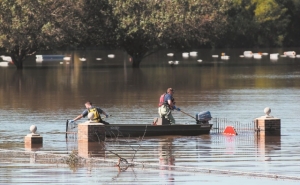Hurricane Matthew: One year later ---- A return to a final resting place
By Ethan Smith
Published in News on October 10, 2017 5:50 AM

News-Argus/CASEY MOZINGO
In this October 2016 photo, firefighters push open the gates of Elmwood Cemetery to recover several of the caskets that have made their way above ground in waters from Hurricane Matthew.
DNA samples were successfully taken Oct. 3 from 18 corpses that floated out of their graves in Elmwood Cemetery during Hurricane Matthew in October 2016, but had been unable to be returned to the ground due to a lack of identification.
This means the deceased that were disinterred by the hurricane and its subsequent flooding are one step closer to being identified and put back in their proper graves. Goldsboro Public Works Director Rick Fletcher said someone from the Office of the Chief Medical Examiner was on site to extract DNA samples from the upper femur bone of the corpses.
After a year of waiting for all the necessary agencies to coordinate to take the DNA samples, Fletcher said the process took about four hours from start to finish.
Emergency Services Director Mel Powers said the DNA samples were sent by FedEx last Friday to an independent third-party lab in Pennsylvania for testing.
Fletcher said the bodies were expected to begin being returned to temporary graves Monday, at a general site in the cemetery.
"We're reinterring them all in one location," Fletcher said. "Then we're going to get a plaque to put up with the names that says these are victims of Hurricane Matthew, and as people come in and visit ... they'll see the names and they'll know."
Then the family members can provide officials with a DNA sample, which will be cross-referenced with the sample taken from the corpses. The bodies will then be returned to their proper graves.
"We've got a map with the location for every one," Fletcher said. "We know who the people are that became dislodged. We know who they are, and we know exactly where they go once we identify the person, we just didn't know which casket was which person. We have a map of all the locations."
A total of 36 bodies floated out of their graves in their caskets, but 18 could not be positively identified and returned to their proper burial sites.
Fletcher said in an earlier interview that some caskets only floated out of their graves part of the way, making it easy to know where to re-bury them.
The others -- the 18 corpses samples were taken from last week -- floated all the way out of the ground during the flooding. Officials decided to hold off on returning them to the ground until positive identifications were made so no coffins were put back in the wrong graves.
Those 18 empty graves were back-filled, awaiting the return of the appropriate casket.
Coordinating all of the appropriate agencies caused the delay in taking DNA samples from the bodies, officials said.
Now that the samples have been successfully harvested, they will only need to be cross-referenced with current family members to be returned to their original graves.
The bodies were buried during the 1980s and 1990s, and did not have identifying information attached to the caskets they were in.
